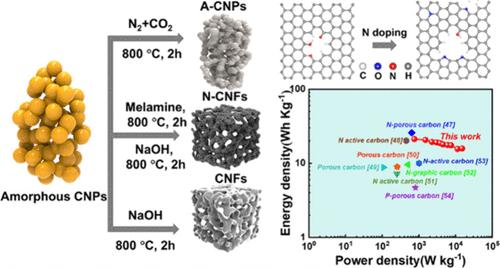超级电容器碳电极协同孔隙度和功能调谐的物理化学活化
IF 3.2
3区 化学
Q2 CHEMISTRY, PHYSICAL
引用次数: 0
摘要
碳基超级电容器电极面临着严峻的挑战,包括无序的孔隙结构、表面惰性和石墨化不足,导致电子传递和界面反应性受损。本研究系统地探讨了物理或化学活化策略对碳电极材料结构和电化学性能的影响。对比分析表明,物理活化(N2/CO2退火)主要导致部分石墨化和适度的颗粒细化,而化学活化(三聚氰胺辅助杂原子掺杂和NaOH蚀刻)可以实现全面的结构重组。优化后的工艺将颗粒结构转化为具有增强表面功能的三维互连多孔框架。化学活化的N掺杂层次化多孔碳框架(N- cnfs)表现出(1)优化的介孔/微孔共存的层次化多孔性,(2)有效的氮结合产生氧化还原活性位点,(3)通过结构石墨化改善了电荷转移动力学,(4)电化学评价显示出优异的性能指标,在1 A g-1下具有443 F - 1的高比电容。出色的循环稳定性,在10 A g-1下循环10,000次后电容保持率为100%,最大能量/功率密度为21.25 Wh kg-1和15.0 kW kg-1。这项工作为通过协调的微观结构工程和表面化学调制开发先进的碳电极建立了一个范例,为储能应用的结构-性能关系提供了重要的见解。本文章由计算机程序翻译,如有差异,请以英文原文为准。

Physicochemical Activation for Synergistic Porosity and Functionality Tuning in Supercapacitor Carbon Electrodes
Carbon-based supercapacitor electrodes face critical challenges, including disordered pore architecture, surface inertness, and insufficient graphitization, leading to compromised electron transport and interfacial reactivity. This study systematically investigates the effects of physical or chemical activation strategies on the structural and electrochemical properties of carbon electrode materials. Comparative analysis reveals that physical activation (N2/CO2 annealing) primarily induces partial graphitization and moderate particle refinement, while chemical activation involving melamine-assisted heteroatom doping followed by NaOH etching enables comprehensive structural reorganization. The optimized process converts the particle structure into three-dimensional interconnected porous frameworks with enhanced surface functionality. The chemically activated N doped hierarchical porous carbon frameworks (N-CNFs) exhibit (1) hierarchical porosity with optimized meso/micropore coexistence, (2) effective nitrogen incorporation generating redox-active sites, (3) improved charge transfer kinetics through structural graphitization, (4) electrochemical evaluation demonstrates exceptional performance metrics with high specific capacitance of 443 F g–1 at 1 A g–1, outstanding cycling stability with 100% capacitance retention after 10,000 cycles at 10 A g–1 and maximum energy/power density of 21.25 Wh kg–1 and 15.0 kW kg–1. This work establishes a paradigm for developing advanced carbon electrodes through coordinated microstructure engineering and surface chemistry modulation, providing critical insights into structure–property relationships for energy storage applications.
求助全文
通过发布文献求助,成功后即可免费获取论文全文。
去求助
来源期刊

The Journal of Physical Chemistry C
化学-材料科学:综合
CiteScore
6.50
自引率
8.10%
发文量
2047
审稿时长
1.8 months
期刊介绍:
The Journal of Physical Chemistry A/B/C is devoted to reporting new and original experimental and theoretical basic research of interest to physical chemists, biophysical chemists, and chemical physicists.
 求助内容:
求助内容: 应助结果提醒方式:
应助结果提醒方式:


